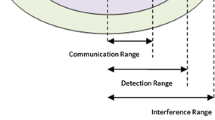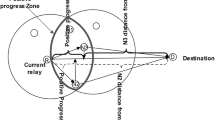Abstract
Vehicular ad hoc network (VANET) is a key element of an intelligent transportation system (ITS), where connected vehicles communicate with the infrastructure wirelessly. The continuous connectivity influences message dissemination, which affects road safety and traffic effectiveness. The integration of VANET with cellular networks is expected to offer benefits like ultra-low latency, extended communication range and high data rates. The high mobility of vehicles and smaller coverage cells demand frequent handoffs to guarantee continuous connectivity with improved quality of service (QoS). Hence, developing a fast, intelligent and reliable handoff scheme is a major challenge. In this work, a two-phase fuzzy logic based handoff scheme is proposed, where the fuzzy based handoff necessity estimation (FHNE) is carried out in the first phase and fuzzy based technique for order of preference by similarity to ideal solution (FTOPSIS) is executed in the second phase for access network selection. Through simulations, it is validated that the proposed scheme effectively reduces the unnecessary handoffs, decision delay, blocking probability and packet drop ratio (PDR) compared to conventional multiple attribute decision making (MADM) schemes.

























Similar content being viewed by others
References
WHO (2020) Stockholm Declaration on Road Safety, 3rd Global Ministerial Conference on Road Safety Switzerland
Zekri A, Jia W (2018) Heterogeneous vehicular communications: A comprehensive study. Ad Hoc Netw 75:52–79
Thirugnanam T, Ghalib MR (2020) A reward based connectivity-aware IoV neighbor selection for improving reliability in healthcare information exchange. Peer-to-Peer Netw. Appl. 13:2112–2122
Ghasempour A (2019) Internet of Things in Smart Grid: Architecture, Applications, Services, Key Technologies, and Challenges. Inventions J 4(1):1-12
Shukla D, Kumar V, Prakash A (2020) Performance Evaluation of IEEE 802.11 p Physical Layer for Efficient Vehicular Communication. In Advances in VLSI, Communication, and Signal Processing pp. 51-60
Ndashimye E, Sarkar NI, Ray SK (2018) A network selection method for handover in vehicle-to-infrastructure communications in multi-tier networks. Wirel Netw 1–15
Mir ZH, Filali F (2014) LTE and IEEE 802.11 p for vehicular networking: a performance evaluation. EURASIP J Wirel Commun Netw (1):89
Dejanovi Z (2017) A new approach for vertical handover between LTE and WLAN based on fuzzy logic and graph theory. In International Symposium on Intelligent and Distributed Computing pp. 81-86
Rahman MA, Salih QM, Asyhari AT, Azad S (2019) Traveling distance estimation to mitigate unnecessary handoff in mobile wireless networks. Ann Telecommun 74(11–12):717–726
Zhu P, Tang L, Sheng B (2012) Minimum SINR based dynamic cell selection scheme for LTE-advanced CoMP systems. In Future Wireless Networks and Information Systems pp. 127-134
Zahran AH, Liang B (2005) Performance evaluation framework for vertical handoff algorithms in heterogeneous networks. In IEEE International Conference on Communications 173-178
Subramani M, Kumaravelu VB (2018) A quality-aware fuzzy-logic-based vertical handover decision algorithm for device-to-device communication. Arab J Sci Eng pp 1–13
Liang G, Yu H, Guo X, Qin Y (2019) Joint access selection and bandwidth allocation algorithm supporting user requirements and preferences in heterogeneous wireless networks. IEEE Access 7:23914–23929
Hassoune MA, Maaza ZM, Senouci SM (2017) Vertical handover decision algorithm for multimedia streaming in VANET. Wireless Pers Commun 95(4):4281–4299
Davaasambuu B, Yu K, Sato T (2015) Self-optimization of handover parameters for long-term evolution with dual wireless mobile relay nodes. Future Internet 7(2):196–213
Ghosh A, Paranthaman VV, Mapp G, Gemikonakli O (2014) Exploring efficient seamless handover in VANET systems using network dwell time, EURASIP J Wirel Commun Netw 227
Ghosh A, Paranthaman VV, Mapp G, Gemikonakli O, Loo J (2015) Enabling seamless V2I communications: toward developing cooperative automotive applications in VANET systems. IEEE Commun Mag 53(12):80–86
Bi Y (2018) Neighboring vehicle-assisted fast handoff for vehicular fog communications. Peer-to-Peer Netw. Appl. 11:738–748
Wang X, Li X, Leung VC (2015) Artificial intelligence-based techniques for emerging heterogeneous network: State of the arts, opportunities, and challenges. IEEE Access 3:1379–1391
Chai R, Cheng J, Pu X, Chen Q (2011) Neural network based vertical handoff performance enhancement in heterogeneous wireless networks. In 2011 7th International Conference on Wireless Communications, Networking and Mobile Computing pp. 1-4
Aljeri N, Boukerche A (2019) A two-tier machine learning-based handover management scheme for intelligent vehicular networks. Ad Hoc Netw 94
Aibinu AM, Onumanyi AJ, Adedigba AP, Ipinyomi M, Folorunso TA, Salami MJE (2017) Development of hybrid artificial intelligent based handover decision algorithm. Int J Eng Sci Technol 20(2):381–390
Calhan A, Ceken C (2013) Artificial neural network based vertical handoff algorithm for reducing handoff latency. Wireless Pers Commun 71(4):2399–2415
Dhar S, Ray A, Bera R (2013) Cognitive vertical handover engine for vehicular communication. Peer-to-Peer Netw. Appl. 6:305–324
Khatri S, Vachhani H, Shah S et al (2020) Machine learning models and techniques for VANET based traffic management: Implementation issues and challenges. Peer-to-Peer Netw, Appl
Wang L (2013) Kuo GSG, Mathematical modeling for network selection in heterogeneous wireless networks A tutorial. IEEE Commun Serv Tutorials 15(1):271–292
Stevens-Navarro E, Wong VW (2006) Comparison between vertical handoff decision algorithms for heterogeneous wireless networks. In: 2006 IEEE 63rd Vehicular Technology Conference. IEEE Vol. 2, pp. 947-951
Drissi M, Oumsis M (2015) Performance evaluation of multi-criteria vertical handover for heterogeneous wireless networks. In: 2015 Intelligent Systems and Computer Vision (ISCV). IEEE pp. 1-5
Stevens-Navarro E, Martinez-Morales JD, Pineda-Rico U (2012) Evaluation of vertical handoff decision algorightms based on madm methods for heterogeneous wireless networks. J Appl Res Tecno 10(4):534–548
Behzadian M, Otaghsara SK, Yazdani M, Ignatius J (2012) A state-of the-art survey of TOPSIS applications. Expert Syst Appl 39(17):13051-13069 20
Yang SJ, Tseng WC (2013) Design novel weighted rating of multiple attributes scheme to enhance handoff efficiency in heterogeneous wireless networks. Comput Commun 36(14):1498–1514
Tzeng GH, Huang JJ (2011) Multiple attribute decision making: methods and applications. Chapman and Hall/CRC
Alhabo M, Zhang L, Nawaz N (2019) GRA-based handover for dense small cells heterogeneous networks. IET Commun 13(13):1928–1935
Pradeep M, Sampath P (2019) An optimized multi-attribute vertical handoff approach for heterogeneous wireless networks, Concurrency and Computation: Practice and Experience 31(20):e5296
Fouladian M, Hendessi F, Pourmina MA (2016) Using AHP and interval VIKOR methods to gateway selection in integrated VANET and 3G heterogeneous wireless networks in sparse situations. Arab J Sci Eng 41(8):2787–2800
Arthi M, Arulmozhivarman P (2017) Power-aware fuzzy based joint base station and relay station deployment scheme for green radio communication. Sustainable Computing: Informatics and Systems 13:1–14
Murugadass A, Pachiyappan A (2017) Fuzzy logic based coverage and cost effective placement of serving nodes for 4G and beyond cellular networks. Wirel Commun Mob Comput
Arthi M, Arulmozhivarman P (2016) A flexible and cost-effective heterogeneous network deployment scheme for beyond 4G. Arab J Sci Eng 41(12):5093–5109
Zineb AB, Ayadi M, Tabbane S (2016) QoE-fuzzy VHO approach for heterogeneous wireless networks (HWNs). In 2016 IEEE 30th International Conference on Advanced Information Networking and Applications (AINA) pp. 949-956
Silva KDC, Becvar Z, Frances CRL (2018) Adaptive hysteresis margin based on fuzzy logic for handover in mobile networks with dense small cells. IEEE Access 6:17178–17189
Calhan A, Ceken C (2013b) Case study on handoff strategies for wireless overlay networks. Comput Stand Interfaces 35(1):170-178
He Q (2010) A fuzzy logic based vertical handoff decision algorithm between WWAN and WLAN. In : 2010 International Conference on Networking and Digital Society. IEEE Vol. 2, pp. 561-564
Subramani M, Kumaravelu VB (2019) A three-stage fuzzy-logic-based handover necessity estimation and target network selection scheme for next generation heterogeneous networks. J Circuits Syst Comput p. 2050092
Yu HW, Zhang B (2019) A hybrid MADM algorithm based on attribute weight and utility value for heterogeneous network selection. J Netw Syst Manage 27(3):756–783
Chinnappan A, Balasubramanian R (2016) Complexity-consistency trade-off in multi-attribute decision making for vertical handover in heterogeneous wireless networks. IET Networks 5(1):13–21
Zineb AB, Ayadi M, Tabbane S (2017) An enhanced vertical handover based on fuzzy inference MADM approach for heterogeneous networks. Arab J Sci Eng 42(8):3263–3274
Subramani M, Kumaravelu VB (2020) Fuzzy logic based handover requirement analysis and access network Selection for Device-to-Device communication. J Circuits Syst Comput
Belarbi K, Titel F, Bourebia W, Benmahammed K (2005) Design of Mamdani fuzzy logic controllers with rule base minimisation using genetic algorithm. Eng Appl Artif Intell 18(7):875–880
Gyekye YN (2010) An intelligent vertical handoff decision algorithm in next generation wireless networks, (Doctoral dissertation, University of the Western Cape)
Zaimi I, Boushaba A, Houssaini ZS, Oumsis M (2019) A fuzzy geographical routing approach to support real-time multimedia transmission for vehicular ad hoc networks. Wireless Netw 25(3):1289–1311
Saaty TL (2013) Analytic hierarchy process. In:Encyclopedia of operations research and management science, Springer pp. 52-64
Dang VT, Wang J, Dang WVT (2019) An integrated fuzzy AHP and fuzzy TOPSIS approach to assess sustainable urban development in an emerging economy. Int J Environ Res Public Health 16(16):2902
Rouyendegh BD, Saputro TE (2014) Supplier selection using integrated fuzzy TOPSIS and MCGP: a case study. Procedia Soc Behav Sci 116:3957–3970
Evangeline CS, Kumaravelu VB (2021) Two-phase access network selection scheme based on weighted sum and game theoretical approaches for vehicular Ad Hoc Networks. J Circuits Syst Comput 2150206
Buyukozkan G, Cifci G (2012) A novel hybrid MCDM approach based on fuzzy DEMATEL, fuzzy ANP and fuzzy TOPSIS to evaluate green suppliers. Expert Syst Appl 39(3):3000–3011
Maniatis SI, Nikolouzou EG, Venieris IS (2002) QoS issues in the converged 3G wireless and wired networks. IEEE Commun Mag 40(8):44–53
Chen YC, Hsia JH, Liao YJ (2009) Advanced seamless vertical handoff architecture for WiMAX and WiFi heterogeneous networks with QoS guarantees. Comput Commun 32(2):281–293
Mahajan A, Potnis N, Gopalan K, Wang A (2006) Urban mobility models for vanets. In: 2nd IEEE International Workshop on Next Generation Wireless Networks, IEEE pp. 33-41
Nelson R (2013) Probability, stochastic processes, and queueing theory: the mathematics of computer performance modeling. Springer Science-Business Media
Abuelenin SM, Abul-Magd AY (2014) Empirical study of traffic velocity distribution and its effect on VANETs connectivity. In 2014 International Conference on Connected Vehicles and Expo (ICCVE) pp. 391-395
Azzali F, Ghazali O, Omar MH (2017) Fuzzy logic-based intelligent scheme for enhancing QoS of vertical handover decision in vehicular Ad-hoc Networks. In IOP Conference Series: Materials Science and Engineering 226(1):012081
Huang CM, Dao DT, Chiang MS (2018) A Bursty Multi-node Handover scheme for mobile internet using the partially Distributed Mobility Management (BMH-DMM) architecture. Telecommun Syst 69(1):113–130
Eiza, M. H., Ni, Q., Owens, T., Min, G., Investigation of routing reliability of vehicular ad hoc networks. EURASIP journal on wireless communications and networking, 2013(1), 1–15 (2013)
Author information
Authors and Affiliations
Corresponding author
Additional information
Publisher’s Note
Springer Nature remains neutral with regard to jurisdictional claims in published maps and institutional affiliations.
Rights and permissions
About this article
Cite this article
Evangeline, C.S., Kumaravelu, V.B. A two-phase fuzzy based access network selection scheme for vehicular ad hoc networks. Peer-to-Peer Netw. Appl. 15, 107–133 (2022). https://doi.org/10.1007/s12083-021-01228-w
Received:
Accepted:
Published:
Issue Date:
DOI: https://doi.org/10.1007/s12083-021-01228-w




